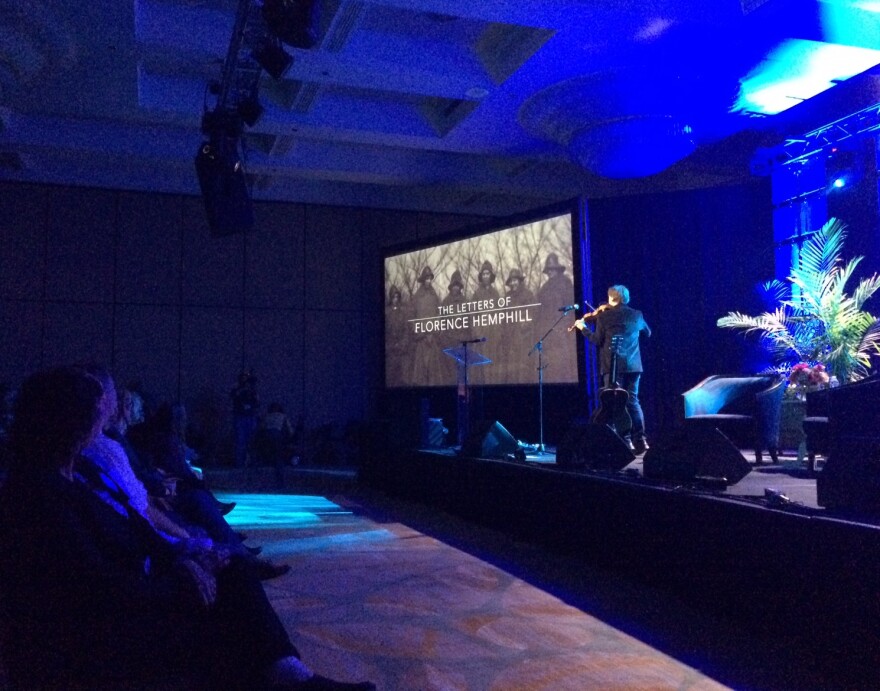Florence Hemphill grew up in a small town in Kansas, and saw the horrors of World War I up close when she served as a nurse in France. She wrote more than a hundred letters, sharing her experiences with family members.
Singer-songwriter Joe Crookston recently teamed up with the National World War I Museum and Memorial to tell her story – through art and music — at the Folk Alliance International Conference in Kansas City, Missouri.
"I’m a songwriter, I play guitar, I play the fiddle, the banjo, and I sing," says Crookston, after a showcase performance at the Westin Kansas City at Crown Center, "but I’m also a painter – because I do a lot of acrylic painting."
When Folk Alliance International executive director Aengus Finnan approached Crookston to take on the role of artist-in-residence, "he had no stipulations whether it was music, or painting, or dance, but [to] do it in collaboration with the World War I Museum. And I said, 'Absolutely, I'd love to.'"
Crookston, who lives in Ithaca, New York, is a storyteller. He says he knew right away he wanted the project to focus on one person. The museum gave him plenty of options.
"I read many, many archived letters that were written in France by soldiers, and sent home to their family in America," he says. "And they have boxes of these original letters that they have scanned. Eventually, it led me to Florence Hemphill."
Florence Hemphill was born in Wilson County, Kansas, and grew up in Chanute. She worked as a private- duty nurse before signing up to serve in World War I. In 1918, she was just shy of 30 when she was sent overseas to France, assigned to the British Expeditionary Force in Rouen.

"And Florence wrote over 100 letters, which we have in our collection," says Lora Vogt, the museum's curator of education.
According to Vogt, only a fraction of the museum's collection is on display — less than 10 percent — so this was an opportunity to reach a larger audience.
"We are making Florence’s story, her life, more accessible, to those who may not have walked in our doors before," she says.
Crookston says he spent weeks reading Hemphill's letters, some written on sheets of blue paper, trying to decipher the cursive. The language and the descriptions she used really captured his imagination.
"The imagery of feeding strawberries to the soldiers, and wrapping up an eye," he uses as examples, "or going out into the bracken fern and drinking tea with the British nurses."
What struck Crookston was the resiliency of these women. And, as he started writing the song, Hemphill became the narrator, looking back on the war.
"The chorus goes like: ‘In the rumbling battle noise, we took care of the boys, so they wouldn’t die alone. And we could send them back home. And when the midnight whistle blew, I donned my boots and navy blue. But anyhow, that’s all over now,'" Crookston sings.
On a late afternoon, one of the large ballrooms at the Westin starts to fill up for keynote speaker and folk singer Judy Collins. Before she takes the stage, Crookston debuts his song.
Folk Alliance executive director Aengus Finnan tells the audience that the artist-in-residence program, in its second year in 2016, requires a leap of faith.
"What it results in is the creation of a piece of work that stands alone outside of the career of an artist, outside of the place in industry – and brings to life the story of someone, like so many, whose stories could have disappeared into time," says Finnan. "And if that isn’t the heart of folk music, I don’t know what is."
Crookston talks about the collaboration not only with the museum, but also with his 11-year-old daughter, who helped with the video documenting the project.
"And I felt like I wanted to celebrate and honor Florence Hemphill as a woman and nurse," Crookston says, "and have my daughter grow up in a world where she could be honored and celebrated as a strong woman."
As Crookston sings, one of his paintings appears on the screen. It is based on a photo of Florence Hemphill during the war. She's standing in a row with other nurses, in rain coats and hats, with a solemn look.
"The song that Joe wrote was just so beautiful – talking about how they wanted to take care of the boys, and talking about the beautiful things that were still waiting for her, in the next part of her life," says Katherine Carter, Hemphill's great-niece. She lives in the Kansas City area, and attended the performance.
Carter says her great-aunt, and the way she lived her life as an independent career woman served as an inspiration. Family members have talked back and forth, exchanging phone calls and emails with their memories of "Aunt Florence."
"This was kind of a saying from my cousin, Nick – she had very little personal time and probably very little time to sleep while she was working – to take the time to write the letters and document that just took a lot of extra effort," says Carter. "And so that just shows how important it was for her to share her stories."
The National World War I Museum has more stories about Florence Hemphill in its collection and on display in Memory Hall – on the east side of the Liberty Memorial Tower, under an oil painting about nurses and their sacrifices during the war.
Laura Spencer is an arts reporter at KCUR 89.3. You can reach her on Twitter, @lauraspencer.





